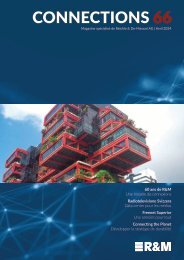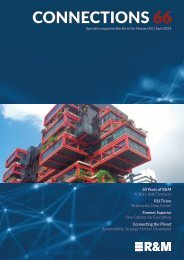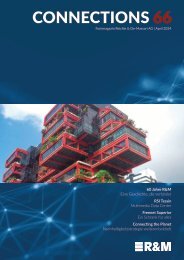CONNECTIONS_65-e
Specialist magazine CONNECTIONS no. 65
Specialist magazine CONNECTIONS no. 65
You also want an ePaper? Increase the reach of your titles
YUMPU automatically turns print PDFs into web optimized ePapers that Google loves.
Trends<br />
030.7622<br />
Cat. 8.1 Applications<br />
in the LAN<br />
Category 8.1 was originally the fastest short-distance runner. With 40 Gbit/s over the<br />
24-meter range, it represented cost-effective hope for data centers. But it also delivers<br />
real peak performance over the middle distance in buildings.<br />
Expectations regarding the effectiveness of<br />
LAN cabling are increasing. The underlying<br />
conditions in buildings have changed to<br />
some extent in recent years. For example, in<br />
connection with the digital ceiling, the LAN<br />
is increasingly being used for expanded and<br />
new applications. These applications demand<br />
unusual peak performance from traditional<br />
LAN cabling. Until now, it has been configured<br />
for 10 Gbit/s over 100 meters.<br />
Above all, it is about networking WLAN<br />
access points (WAP) and distributed antenna<br />
systems for 5G DAS. These are sporty, bandwidth-hungry<br />
applications. WiFi 6 WAVE2<br />
and WiFi 7 require bandwidths above 10<br />
Gbit/s. But there are also computing-intensive<br />
applications in research and multimedia<br />
that can benefit from higher bandwidths.<br />
Standard offers a way out<br />
This could be solved elegantly with Cat. 8.1<br />
if it weren’t for the length limit of 24 meters.<br />
However, standardization offers a way out.<br />
The TR11801-9909 defines how Cat. 8.1<br />
cabling can also transfer 25 Gbit/s up to 50<br />
meters. Overall, three length-dependent performance<br />
levels can be presented for a Cat.<br />
8.1 installation: 40 Gbit/s up to 24 meters,<br />
25 Gbit/s up to 50 meters and the classic 10<br />
Gbit/s up to 95 meters (graphic).<br />
What does this mean for practice? Based<br />
on the typical distribution of link lengths,<br />
Cat. 8.1 cabling could make a significant<br />
contribution to increasing the performance<br />
of the LAN. In a typical office infrastructure<br />
with a floor distributor, Cat. 8.1 cabling could<br />
supply around 20 % of workstations with 40<br />
Gbit/s and around 60 % of workstations with<br />
25 Gbit/s within the 24-meter range.<br />
Complete Cat. 8.1 solution<br />
With the Cat. 8.1 system, the R&Mfreenet<br />
program offers an RJ45-compatible solution<br />
for bandwidths of up to 40 Gbit/s.<br />
The complete system comprises connection<br />
modules, patch cords and installation<br />
cables. It passed the GHMT test. The<br />
channel is certified for 40 Gbit/s up to<br />
30 meters, 25 Gbit/s up to 50 meters.<br />
cabling in the LAN can cover the requirements<br />
for future data cabling with maximum<br />
bandwidth and full backward compatibility.<br />
www.rdm.com/cat-8-1/<br />
030.6289<br />
Variable speed zones in the LAN with Cat. 8.1<br />
(Graphic: R&M)<br />
In modern buildings, redundant floor distributors<br />
are often installed, with correspondingly<br />
shorter transmission lengths. Under this<br />
concept, the Cat. 8.1 infrastructure could<br />
serve more than 50 % of workstations with<br />
40 Gbit/s and all others with 25 Gbit/s.<br />
This is true excellence as it is expected today<br />
and tomorrow. With suitable planning, Cat. 8.1<br />
050.7067<br />
Matthias Gerber<br />
Market Manager LAN Cabling<br />
matthias.gerber@rdm.com<br />
18 | <strong>CONNECTIONS</strong> 10|2023–<strong>65</strong>

















